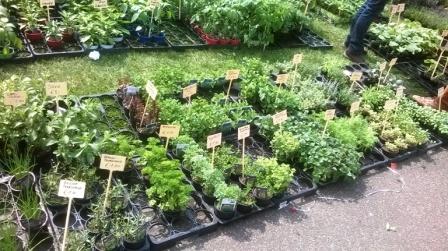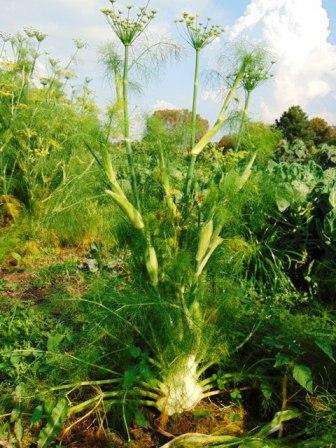The prehistoric Europeans already used herbs to make food tastier. In about 7,000 years old pots from the Baltic states were found deposits of seeds, closely resembling that of hedge garlic. Because the plant has little nutritional value and in the pot were also traces of meat and fish remains, researchers concluded it was used as a condiment and not as a main component of the meal.
Alliaria petiolata, or - officinalis occurs in deciduous forests, and is even today still used in the kitchen.
 Herbs are aromatic seasonings. There is no botanical distinction from other species and /or vegetables. The amount we use it determines whether it is an herb. Sage was formerly a vegetable, now it is used as a spice.
Herbs are aromatic seasonings. There is no botanical distinction from other species and /or vegetables. The amount we use it determines whether it is an herb. Sage was formerly a vegetable, now it is used as a spice.
To many spices are healing properties assigned. Vegetables have this also.
Of green herbs you can cut stalks and pick leaves and seeds. They recover and continue to grow. Each herb exists in several variants.
Basil (Ocimum basilicum)
In ancient Greek, "Basileus" means king. It is sometimes called kings herb. Basil is often combined with tomato. The herb should not be cooked and is best freshly processed. Dried it loses much flavor. Taking the flower buds away promotes growth and yield.
Chives (Allium schoenoprasum) prairy onion or garlic chives. See also < Onion - family)
Chives are a perennial plant with edible, grass-like, hollow leaves and purple flowers.
The leaves have a mild onion flavor. You can cut it short.
Savory (Satureja -)
- Hortensis (summer) is annual, a fine species with long narrow leaves with a to pepper -leaning taste and aromatic odor. The plant dies at the first frost.
- Montana (winter-) perennial savory with a stronger flavor and darker leaves.
Savory is widely used in legumes.
Lemon balm (Melissa officinalis)
Lemon balm blooms with small white flowers. If you touch the leaves they spread a fresh lemon scent. The plant grows lush and sows easy further. You can have the whole summer to pick for soothing tea.
Dill (Anethum graveolens)
The plant has a hollow, shiny stem, pinnate fragile and wiry leaves. The seeds are used in food, tea, and e.g. pickling cucumbers and gherkins.
Tarragon (Artemisia dracunculus)
Tarragon is a perennial plant that still requires some protection in the winter. You can take cuttings or tear them to increase. Sowing succeed in our region. Dragon has a bitter, peppery anise flavor.
Hyssop (Hyssopus officinalis)
Hyssop is a shrubby plant with purple-blue flowers. The dark green leaves are pointed oval and have a strong, bitter flavor with a hint of mint. In severe winters, the bush must be shielded.
Chervil (Anthriscus cerefolium)
Chervil is hardy.
Sweet cicily (Myrrhis odorata) is perennail and has a more pronounced sweet, anise-like flavor. The fern-like leaves are larger than those of the ordinary chervil. Also, the seeds are used.
Borage or starflower (Borago officinalis)
The aroma and flavor of this plant seems a bit cucumber. Can also be cooked like spinach.
Coriander (Coriandrum sativum)
The leaves are reminiscent of tiny celery leaves and have a slightly spicy, anise -like flavor. The seeds are about the size of peppercorns which they also equal.
Laurel (Laurus nobilis)
At the Greeks the winners of the Olympic Games received a wreath made of laurel branches (laurels wreath).
Laurel is a woody and evergreen shrub that is dioecious: male and female flowers are on separate plants. He's actually not fully hardy (to approx - 5°C).
You can increase plants in September by cuttings.
Lovage (Levisticum officinalis)
This huge perennial goes up to 2 m but dies off above the ground during the winter. The highly aromatic, at celery tasting plant can be propagated by seed and cuttings.
Lavender (Lavandula angustifolia)
Lavender has evergreen, gray-green leaves, which smells wonderfully soothing when touched. The flowers are purplish blue, white or pink. The plant should be pruned annually.
Sweet woodruff (Asperula odorata)
Woodruff is a hardy (perennial and ground covering) herb with white, star-shaped flowers and narrow green leaves in whorls of 6 or 8. It is about 15 to 20 cm in size. Very aromatic, it smells only after cutting and drying. The root sprouts can also be teared and replant. If the dried plant smells brighter, rain is expected.
Marjoram and oregano (Origanum majorana / Origanum vulgare)
Both plants belong to the genus Origanum. Marjoram has small leaves with an exotic aroma and white flowers. Those of oregano are bigger and have a stronger flavor. They are happy in full sun.
Horseradish (Armoracia rusticana)
The pin root has a very sharp, mustard like and spicy taste. It is an invasive and perennial plant that spreads rapidly with every piece of root in the soil. The dried root is used, or even freshly grated in raw vegetables such as cabbage salad, cream cheese, mayonnaise.
Remove the flower stalk (s), which improves the quality of the root (s).
Horseradish can be long preserved (approximately one year).
The strong pungent taste is mitigated by cooking. The leaves are also edible (and a remedy for pain from nettle stings).
In Japan, the stronger version (Wasabia japonica) is a permanent part of sushi, called wasabi.
Mint (Mentha x piperita)
You can tame this overgrower by keeping him in a jar. The flowers vary from light pink to deep purple. The fresh leaves have a typical mint flavor through the ethereal menthol oil, which quickly evaporates. Delicious as a tea or as an appetizer.
Parsley (Petroselinum crispum)
Flat leaf parsley has more essential oils and flavor than curly.
Curly parsley is more decorative. The taste is best when you add the leaves at the last minute and fresh chopped to a dish. The root is edible.
Rosemary (Rosmarinus officinalis)
Rosemary is an evergreen shrub with very fragrant leaves and edible violet blue flowers. In severe frost rosemary needs shelter.
Rosmarinus literally means dew of the sea (near where it naturally occurs). Propagation is by cuttings or layering.
Sage (Salvia officinalis)
Sage has gray-green, velvety leaves and violet blue flowers. The fresh or dried leaves have a strong, woody aroma.
Thyme (Thymus vulgaris)
Thyme is a hardy, evergreen shrub with fine, aromatic leaves and small purple flowers. Can be used fresh or dried.
Thyme contains thymol. Thyme syrup is good for the respiratory system, cough and asthma symptoms. Fennel (Foeniculum vulgare)
Fennel (Foeniculum vulgare)
The hardy herb fennel has bright green, hair like leaves with a subtle, pleasant anise flavor. He sows itself. Serve with fish or in a summer salad, and pretty as a garnish. Fennel is used as a vegetable.
Saffron is used as coloring and flavoring in paella, risotto, rice pudding, bouillabaisse. A wire saffron may color a liter of boiling water in an hour to deep yellow. From the saffron crocus (Crocus sativus), parts of the pistils: the styles and the punches, are hand harvested and dried. An experienced picker harvests thousand flowers per hour if they are close to each other. And an experienced processor pelts 250 flowers per hour. Saffron is very labor intensive and time consuming, and expensive: 30 to 40,000 Euros per kilo, or 30 to 40 Euros per gram of saffron.
In Belgium there are five growers. The saffron crocuses are planted in July and flower in October-November for four to six weeks. If the night temperature drops the bulbs bloom with one, two or three large mauve flowers.
The flowers are peeled and pistils removed. Each crocus has three pistils. The upper red part is the best. Three pistils weigh about 7 milligrams. For 1 gram so 150 to 200 flowers are needed. If the pistils have been cut, they are weighed and dried in an oven to exactly lose 80% of their weight. To improve the quality and taste they are kept cool and dark in a sealed jar for six weeks.
Difference herbs - spices
Spice comes from Latin species: "kind, type” over the Old French “espicerie' spices, seasonings.
Spices are aromatic or pungent -tasting dried parts of tropical plants, including flower buds (cloves), roots (turmeric, ginger), pods (cardamom), stamens (saffron and vanilla), sometimes the seeds (nutmeg, mustard, caraway, allspice, coriander, pepper), but also the fruit (mace (seed coat), cassia) and bark (cinnamon).
Herbs are leaves and stems of green non - woody native plants that so often grow in temperate climates. The flowers, seeds and roots are used.
Herbs have more flavor when fresh, while spice scents more in dried powder form.
The flavor of spices is usually sharper and spicier than herbs.
